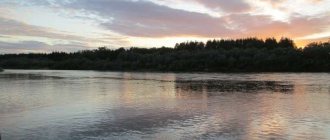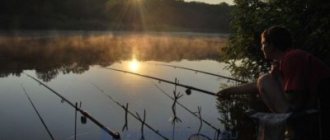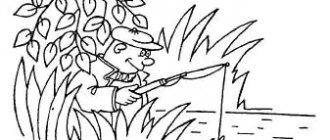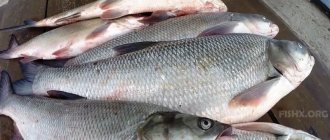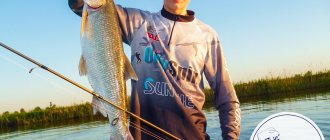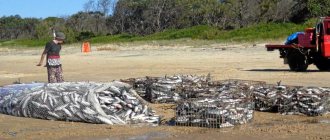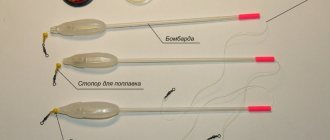Fishing time and weather conditions
You can catch an asp using live bait at almost any time of the year. He readily catches small fish from early spring to late autumn. In winter, a sheresper is caught on a hook only occasionally. Often its capture is unplanned and it becomes bycatch when hunting other predators - pike, pike perch, burbot or perch.
The asp is a diurnal predator; it is most active in the morning and at dusk. Moreover, too early or too late, in low light, it works worse. During the day it continues to hunt, especially in summer, going out onto spits and sandbanks.
Tip: You can detect the localization of an asp by characteristic bursts that are audible and noticeable from a long distance.
It is better to catch asps in stable warm weather in places where a school of small fish feeds. On stormy and rainy days, the predator becomes passive, rarely shows its presence in the surface horizon, feeds little, and almost does not react to live bait.
What live baits are required
It is known from practice that the most desired trophy for the asp is bleak, which lives in schools in the upper layers of the water, where he hunts for it. This fish is delicate and requires very careful handling when hooking and casting. If you have to cast bait over a long distance, you should be prepared for a large consumption of live bait, which most often flies off when pulling in the tackle.
Small, up to 10 cm, roach, gudgeon or even chub are well suited as live bait. You can try to catch an asp using perch or crucian carp, but they are not the usual food for the asp, so they may not work.
There are three ways to attach live bait:
behind the dorsal fin (frequent changes of fish are required due to losses during recasts);
by the lip;
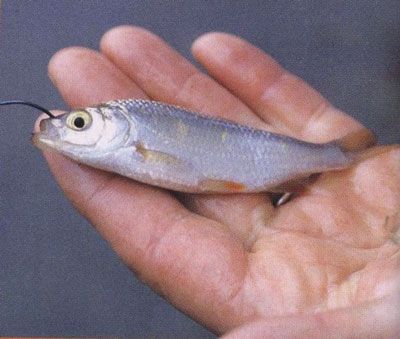
under the gills with subsequent withdrawal of the hook through the mouth.

Other methods are derivatives of those listed.
Gear selection
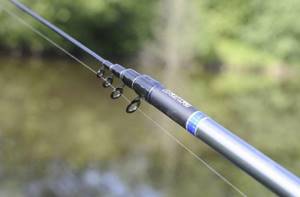
Tackle for catching asp with live bait is selected depending on the time of year:
- In early spring and in the second half of autumn, the predator stays in the near-bottom horizon. That’s why donka is often used for fishing.
- In the middle of spring and autumn, as well as during prolonged cold spells in the summer, the asp hunts in the water column. Match gear with blind rigging comes to the fore, allowing you to present the bait in the desired horizon.
- In summer, the asp feeds near the surface. To catch it, you should use float rigs that allow you to keep the bait in the upper layers.
Recommended reading: How to catch pike perch with live bait
The most versatile fishing rod is considered to be for long casting. It is designed for fishing from the shore, regardless of the horizon of the predator.
Rod
Long-distance casting gear consists of a match or spinning rod designed for equipment weighing from 15 to 40 grams. The range of the kit is achieved due to the length and action of the tool. For an asp, it is better to take a medium or slow “stick” 3–5 meters tall.
Coil
The rod is equipped with a spinning reel, which should perfectly balance with it, without tiring the angler during the fishing process. It is better to take a product from a well-known manufacturer with good line laying, a velvety stroke and a sensitive friction brake.
fishing line
A monofilament line with a thickness of 0.28–0.35 mm with a breaking load of at least 5 kg is wound onto the reel spool. The nylon thread flies far, is invisible in the water and does not alarm a suspicious asp; when biting and retrieving, it confidently dampens the jerks of the weighty predator.
Float
A transparent plastic ball is often used as a float. Its main task is not to signal a bite, but to help the fisherman track the location of the bait so as not to lose sight of it. There are models that are filled with water, making the equipment heavier and increasing the casting range and accuracy.
Note! The asp is a cautious predator, so the stealth of the gear determines the effectiveness of its fishing.
The equipment consists of:
- leash;
- hook;
- lead load.
For the leash, use fluorocarbon or monofilament thread with a smaller diameter than the main line. Its length is 0.7–2 meters, depending on the fishing conditions, the horizon where the sheresper is located, and the fishing distance.
A single leash is tied to the leash, or less often a double. When assembling the equipment, you must ensure that the hook is located at a distance from the float, without arousing suspicion in the asp. When fishing near the surface, the equipment is not weighted; when fishing in the depths and near the bottom, you have to put lead weights on the line to keep the bait in a given horizon.
We recommend reading: Catching pike perch with amphipods
Catching asp from ice
Catching asp from ice is only possible in places where there are potholes in the river, there is a strong current near the holes, or the water is otherwise well saturated with oxygen. To catch a predator through a hole, you should use:
- Donka with a leash more than 20 cm long, the so-called “fool”;
- The vertical lure method uses narrow spoons, jigs or castmasters.
- Sometimes you can try using silver pike-perch spoons.
You can approach the potholes on the ice with a regular spinning rod, but it’s worth remembering that the ice is very thin at the water’s edge. In order not to fall through, it is advisable to position yourself for fishing 10-15 meters from the ice edge. In this case, you need to stop not above the current, but on the side of it.
How to properly catch an asp using live bait
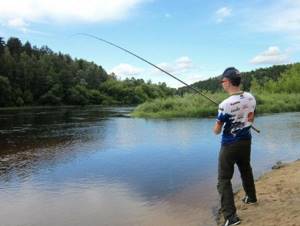
The tactics of this fishing differ from the classical one and are more similar to fishing for perch and small pike using a running bottom. The fisherman casts the equipment at a given distance and floats it downstream, controlling the speed of descent and the trajectory of movement using the rod and line tension.
After passing through the promising zone, the equipment should be reeled out and re-cast. Depending on the fishing conditions, the angler can stand still, performing a short retrieve, or move along the shore, allowing the bait to travel a long distance.
When fishing with live bait using rafts, one must not forget about camouflage. The asp has good eyesight and hearing. Any suspicious object on the shore will alert him, and the predator will refuse to attack the bait. If the tackle does not involve long casting, then you should not wear bright clothes. It can be useful to hide behind coastal bushes. Try not to make noise.
When fishing with donkeys, you do not need to move along the shore. The gear is installed permanently, and the equipment is located at the bottom. The fishing range, as a rule, is not lower than average. In this case, camouflage will not hurt, but is not necessary. The main thing is to be quiet, don’t shout or stomp.
About live bait and bait methods
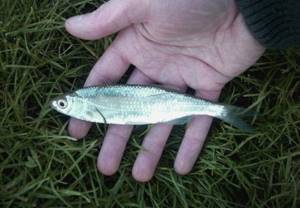
The best live bait for catching asp will be the one that represents its natural food. The predator feeds mainly on bleak, so the choice in its favor is obvious. Also suitable:
- perched water;
- small roach;
- juvenile chub;
- gudgeon.
The size of live bait is 5–10 cm. It is important to keep it as fresh and active as possible, since the listed fish species quickly fall asleep, losing their attractiveness to the sheresper. To do this, the bait must be stored in appropriate conditions, changed regularly, and placed correctly on the hook.
There are two main options for placing live bait on a hook: by the lips and through the gills with output through the mouth. The second method is more reliable, since the fish confidently stays on the double or single and does not fly off during splashdown or when biting an asp.
Recommended reading: Texas spinning rig
Biting, hooking and fishing
The asp grabs the bait powerfully and sharply. A predator rarely takes the bait gently, without a characteristic jerk.
On a note! Hooking is often not required, since the fish itself sits securely on the hook. The fisherman only performs a “duty” short swing of the rod in order to minimize the likelihood of getting lost when fishing.
Once on the hook, the predator makes sharp, strong jerks, moves to the side, and can go to the surface, where it makes pirouettes, trying to free itself. Despite a powerful start, it quickly fizzles out and weakens. When bringing the asp to the shore, it is better to use a landing net, although experienced fishermen calmly take it with their bare hands.
How to properly mount live bait
As live bait we use the fry that the asp feeds on in the pond in question. For this predator, bleak is preferred, which is why we choose bleak, roach, chub or gudgeon that are similar to it. Live bait should not be more than 10 cm in length. Fresh and active fish are the most desirable prey for the sheresper. We create appropriate conditions for storing bait.
Catching asp from the shore with live bait involves 2 options for bait attachment. In the first case, you can hook the hook to the lip, in the second, you can bring the hook through the gills into the mouth. Most Astrakhan fishermen prefer the second method, since this way the hook does not fly off when a predator bites.
Tips from the experts
Advanced anglers can provide useful advice. They help achieve the most stable results throughout the year. Here are some of them:
- The best way to fish for sheresper with live bait is a float tackle for long-distance casting. Bombarda and Donka are noticeably inferior in productivity.
- The best live bait for asp is bleak.
- Camouflage and caution are important for successful open water fishing.
- The most favorable period for asp fishing with live bait is the warm water season, from the second half of May to mid-September.
- The predator is most active in the morning and evening in warm sunny weather with a slight breeze and rare clouds in the sky.
You can catch an asp in different places, but the most promising are sandy rifts and shallows, locations near bridges, steep banks with overhanging and submerged trees.
Tactics and fishing techniques
In the spring, when the asp has just recovered from winter, catching it with live bait is not very promising. At such times he is interested in worms and larvae. At the end of spring, many insects fly out, many of which, falling into the water, are an excellent bait for the asp. Effective fishing for sheresper with live bait begins in the summer. Only in the warm months does this predator become accustomed and begin to feed on fry and various types of small fish. Autumn is the period of trophy specimens of predators, so the size of live bait can be increased. The asp is a heat-loving predator that is most active on the hottest days. The best bite should be expected in the morning and evening, although during the day it can feed several times at very different times. The sheresper is very picky about the weather and will not bite during periods of changes in weather or atmospheric pressure. You need to go fishing for it when the weather is stable for several days.
The tactics for fishing with live bait is to move the bait downstream in promising places. To achieve a positive result, you have to lower the live bait over decent distances - 30 meters or more.
If fishing occurs from the shore, an element of camouflage for the fisherman is mandatory. Careful casting of the tackle should be done from behind a bush or other cover. If there are no shelters on the shore, then it is advisable to use a camouflage suit that matches the color of the shore and make a minimum number of movements when fishing. If there is an opportunity and the fishing location allows it, then you can go into the water, even if it’s hot. In this case, the sheresper will not be wary and the fisherman will not be afraid. The most convenient option for fishing for sheresper is fishing from a boat. In this case, the angler can fish any area of the reservoir without the risk of being noticed. And the asp is not afraid of fishermen from a boat, just as he is not afraid of those who enter the water.
Promising places where asp can be successfully caught using live bait are the following elements of the reservoir:
- sandy rifts;
- places of current change;
- places behind the pier, bridge piles, dam;
- next to a snag or a tree sticking out of the water;
- under trees and bushes hanging over the water.
A clear sign of the accumulation of asp in some place of the reservoir is the presence of seagulls above this place, which periodically descend to the water and pick up the fry. This sign means that a flock of asps is feeding in this place, and at this moment you can launch a rig with live bait into this place.
Another sign of the presence of asp is constant outbreaks in one area. The fight of an asp is different from the fight of other fish. It resembles hitting water with a shovel. This asp jumps out of the water and hits the water flat. The presence of asp strikes indicates that the asp’s hunting trail passes through this area, and in such a place it is possible to launch a rig with live bait.
The asp's bite is extremely energetic. The impact can be so strong that it can knock the rod out of your hands. Therefore, when catching a river corsair, you do not need to lose your vigilance, but keep your tackle tight and be alert all the time. When biting, the asp drags the rig from side to side. This must be taken into account when fishing near snags.
So, catching asp with live bait may be promising when other fishing methods do not produce results. The ball float rig is very easy to assemble and use. It is much more practical compared to other live bait gear. Therefore, the use of this type of gear is absolutely justified, especially in the fall, when the probability of catching a trophy sheresper is high.
Source: fishelovka.ru
Features of asp fishing depending on the season
Fishing in spring
Peculiarities of asp catching in spring include the following factors:
- During this period, fishing must be done only from the bottom of the reservoir, using fishing almost along the bottom.
- Not having much strength after the winter period, the asp swims to areas of the reservoir with a very weak and non-pressure water flow.
- It is better to conduct wiring along the growth of reeds and various rifts at a depth of 3 to 6 meters.
- The most catchable distance is from 10 to 40 meters.
To catch asp in the spring, it is recommended to use the following gear:
- Strong spinning rod.
- Reliable fishing line with a diameter of up to 3 mm.
- Spoons and baits depending on the specific fishing location.
The most suitable baits are spinners, wobblers and rubber fish.
Also in the spring you can fish with fly fishing gear, which is used only when catching asp from the shore. For bait, this tackle can be used with both live and artificial bait.
Fishing in summer
The summer period creates favorable conditions for catching asp, which prefers to stay close to shallow water areas in the summer, and often alone. Lures for fishing in summer can be varied. In general, since the asp is a predatory fish, all insects, worms, butterflies and caterpillars are suitable.
For catching in the summer season, you can fish both from the shore and from a boat
.
The most effective method of casting a line is to cast against the flow of the reservoir. In this case, success occurs due to the fact that the bait behaves differently during a slow retrieve.
Fishing in autumn
Catching asp in the autumn is very effective, since the fish senses the approaching cold weather and begins to bite more often. At the end of August, the asp begins to form large flocks, or as they are also called “cauldrons”.
Since the water becomes more transparent during this period, the fisherman should wear some kind of camouflage so as not to scare off the fish with his appearance. To catch asp in hard-to-reach places, you should use a fishing rod 2-2.5 m long with a spinning reel with a high subordinate number. It is advisable to place monofilament fishing line in the reel.
At the end of autumn, when the fish is already moving to the depths, it is customary to catch it using the jig method, using the following baits:
- Twisters.
- Vibrating tails.
- Rubber and other soft-bodied baits.
- Turntables.
Also popular is the use of a spinner such as Kastmaster.
The peculiarities of catching asp in the fall are that you should especially carefully throw gear into the “cauldrons” so as not to scare the fish. The best option would be long-distance casting using a wobbler.
Fishing in winter
Catching asp in winter is very difficult and inactive. The main gear for fishing is spinning.
Best fishing spots:
- Zones below the riffles.
- Areas near bridge piles.
- Artificial reservoirs.
- Non-freezing reservoirs where the asp does not sink to the bottom, but continues to hunt.
In open water in winter, asp can only be caught during the day. You can use worms, bleak fish or other live bait as bait. But since the asp usually does not actively bite in winter, the catch during this period is considered very rare.
Fishing rod rig
As already mentioned, the asp is a very strong fish, with powerful jerks, so the tackle for catching it should be quite strong, but at the same time, you cannot use very rough tackle, as this may negatively affect the catching of the asp, which may refuse to bite if he is alerted by a thick fishing line or a bright float. The asp will not take the bait even if it notices an angler on the shore, so to catch it, you need to be very careful and use equipment varying between roughness and caution.
Depending on the size of the standard asp that lives in the fished body of water, use a fishing line no thinner than 0.2 mm, but no thicker than 0.3 mm. If you come across very decent specimens in the river, then you can go a little beyond the 0.3 mm line, but if no one has seen an 8 kg asp in your pond, then using a line with a diameter of 0.3 or more will be a big mistake. The hook is used No. 7-10 according to domestic qualifications.
It is best to buy a transparent float for asp. These are special floats designed mainly for asp fishing. They can be oblong or completely round, like a ball. Transparent floats remain completely unnoticed by the asp or are mistaken for an air bubble on the surface of the water, and therefore do not alert this predator in any way. By the way, a leash for an asp can be used with the same diameter as the main line, but it’s better to have a slightly smaller one. So, the equipment:
- fishing line 0.2-0.3 mm;
- hook No. 7-10 in Russian;
- float - transparent;
- a strong rod, no shorter than 3.6 m, preferably with a spinning reel, for long-distance casting.
Asp lifestyle
The nickname given to this fish by spinners – “river corsair” – suggests that it is more often found in large rivers and large tributaries. Prefers to stay in places with clean water and strong currents.
There is a lacustrine form that lives in reservoirs and lakes. Lake asp is much less common. Leads an exclusively daytime lifestyle. It is almost impossible to catch a sheresper at night.
It eats large quantities of bleak, gudgeon and juveniles of other fish. In early spring and autumn it also feeds on river worms and large insect larvae and frogs.
What other gear is used?
In addition to a float rod, you can catch asp using bottom tackle, in which the live bait is located above the sinker and, due to its own movement and under the influence of the current, moves in the water column. However, this method has three significant drawbacks:
- The gear is in a limited space, and the angler may not get to the place where the asp is “fighting.”
- Live bait is located much below the surface of the water and can be invisible to this predator, which prefers the upper layers for hunting.
- When casting long distances with a load, there is a high risk of the fish falling off the hook when falling into the water.
Sometimes fishermen use a fishing technique such as Sbirulino (bombard) to catch sherespers. In fact, this technique is even closer to spinning fishing. Here, in order to cast a light bait to the required distance, a special weighted float called a bombard is used. It has a built-in weight or, before fishing, it is filled with water until the weight required for immersion is reached, and the fishing line is threaded through the entire length.
To attract the asp, the tackle is carried through the water column at a certain speed, and the baitfish in such conditions quickly dies and flies off the hook. Therefore, here fishermen use a hard tackle to bait an already dead fish. The disadvantage of this fishing method: the bait quickly becomes unusable due to frequent casting.
The best baits for asp
In spinning gear, this predator is caught using spoons and wobblers. Silicone twisters and vibrating tails are less popular because their successful use is seasonal and requires mastering special fishing techniques. Descriptions of baits are best presented using specific models as examples. This approach will help you better understand what to catch asp with.
Spoons
All lures that are supposed to be used in catching a wary asp are subject to certain requirements:
- The bait should in appearance resemble the natural prey of a river corsair. For this reason, light silver-colored spinners are best suited. However, in some cases, copper tones also give good results.
- In pursuit of casting range, we must not forget that this fish ignores fast-sinking lures. Therefore, it is necessary to find a clear compromise between the weight of the bait and the fishing distance.
- Often the predator chases small things in the current. The asp spoon should not play steadily in the current without stopping its movements in the water layer.
Classic spinner for asp fishing – Mepps Aglia Long. Size – starting from the third. The successful combination of a “willow” petal with a heavy core allows this model to fully reveal its game even in strong currents. It has excellent flight properties, but sometimes the treble hook gets caught in the fishing line. An additional advantage is low cost.

Spinner Mepps Aglia Long
Among the vibrators, the Kastmaster series should be highlighted. The unique animation of this bait is ideal for catching asp, and the shape ensures precise delivery over long distances. Thanks to the movable tee, when the fish bites, a strong hook occurs. It is noteworthy that cheap analogues of castmasters are not inferior in catchability to the originals. The main thing is to choose the right color and size of the spoon.

Kastmaster
Kosadaka Quant V2 rotating wobblers of mixed type show good results. These lures have a removable weight in front, followed by an elongated petal and a sharp, hairy tee. This combination gives confident animation of the turntable with various types of wiring. Once in the water, the split spoon immediately begins to work, which is paramount in the hunt for sheresper in the so-called “cauldrons”. You can work with the Kosadaka Quant bait at different horizon levels.

Kosadaka Quant V2
To the listed requirements for floating baits, one more is added, related to a specific parameter - the degree of depth. For hunting river corsairs, minnow-type wobblers are most often used, since their shape more accurately conveys their usual prey.
The asp leads a pelagic lifestyle, which means that this fish prefers to stay in the water column. For this reason, using wobblers with a working depth of more than 1.5-2 meters does not make sense. Superbuoyancy should also be avoided; the bait should play at some distance from the surface of the water.
As an example of a typical wobbler for asp, we can name the ZipBaits Rigge 70S sample. This is a wonderful and extremely catchy model that should be in the arsenal of any angler.
Soft baits
Finding a silicone decoy to catch a river corsair can be a difficult task. But if you manage to find a successful twister or vibrotail, your success will exceed your wildest fishing expectations.
For the reasons already stated, it is good to try searching for fish on a model with additional weights. By feeding the vibrating tail into the perspective stream, you should try not to let the animation stop. To do this, wiring is done in such a way that the bait moves towards the shore at an obtuse angle in the direction of the current. Long pauses should be avoided.
It is difficult to name a specific type of silicone fish that is best suited for fishing. In different bodies of water and depending on many external factors, the result from using the same baits can be completely different.

Fishing places
The asp is most common in medium and large rivers, which have rifts and rapids in their beds, on which it likes to hunt.
The asp has an upper mouth structure, which indicates that this fish hunts in the upper layers, often collecting fallen insects and beetles from the surface of the water. But the asp is not always found only on the surface; in the fall it is quite often found and caught at a decent depth, it loves such places very much, but in spring and summer it is better to catch it on top.
The location of the asp is mainly determined either by its fight on the surface of the water while the asp is hunting for small fish, or by the fleeing bleak, which scatters in all directions, jumping out of the water, while trying to escape from the predator. You can often find asps where seagulls circle. The fact is that the asp drives small fish to the surface and forces them to jump out of the water; the seagulls cannot ignore this and immediately flock to such easy food, having a feast at the asp hunting site.
Asp can be found both in river bays and on their fast flow. He loves places where there are large concentrations of his favorite food - schools of bleaks. Where there is a lot of bleak, there should be asp. This is a kind of natural bait for asps that does not need to be purchased or prepared.
In general, when the water warms up, the asp moves to shallow areas of the reservoir, since this fish is very heat-loving. On warm summer days it can be caught on riffles, shallows, and sections of rivers below dams.
When searching for an asp, it is very important to be behind some kind of cover - behind a bush, tree or something similar. If the asp notices you, you can forget about the bites. If there is no shelter on the shore, use protective clothing and cast while sitting. By staying close to the ground, you reduce your chances of being noticed by fish and increase your chances of getting a bite.
The equipment used for catching asp with a water-filled float is quite simple.
A meter-long leader with a fluorocarbon leash and a hook is attached behind the float. The bait is usually flying insects and grasshoppers. In addition, fry can also be hooked. If you float such bait under the branches of bushes and trees, this can be a very effective way of fishing, since everything in such fishing looks natural. After all, asps, ides and chubs often stay in the shade of trees in the heat, picking up insects falling from the branches. When floating bait like this, you only need to occasionally hold the float so that it does not get ahead of the hook with bait. This holding, by the way, is also a game technique that can arouse the interest of a predator, since the bait oscillates and moves unevenly at the moment of holding.
When the asp doesn’t go for the bait...
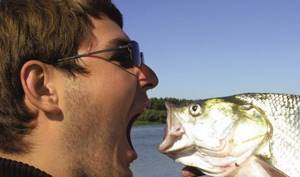
Each asp has its own character; there seems to be no general rule of behavior for this fish.
Most fishermen prefer to hunt for this predator with a spinning rod, but few have caught an asp with a live fish using a fishing rod or bottom. Many people do not believe in such fishing, and if they suddenly see that an asp is being caught in front of their eyes in an unusual way, then many questions immediately arise. I will talk about live bait fishing for asp, based on personal experience.
I learned how to consistently catch asp with fry and live bait, and large ones at that, in the Lower Volga. That time, my friends and I tried to catch an asp striking right under the fishing base, but to no avail. Suddenly I saw a small flock of cape in the shallow water and splashed the change onto the shore with my foot. I baited the hook of a match fishing rod with a fish and threw it into the battle area. A bite immediately followed, and an asp weighing about a kilogram was on the hook. This asp was followed by the next one, then another and another... Now the river “corsair” was not cautious, as was the case with the lure, but took it confidently.
Each asp, especially those living on calm water, has its own character. There seems to be no general rule of behavior for this fish. In general, a schooling asp and a solitary asp are not the same thing. An asp feeding in a “cauldron”, where the water seems to be boiling, and the feeding fish flickers and sparkles everywhere with its sides, is not difficult to catch either with artificial or natural bait - the main thing is to sneak it to the battlefield. But when a single live bait swims, the asp often does not react to it. And here we should dwell on a very important point. Some fishermen believe that the asp drowns the fry with its tail. Actually this is not true. When he wedges himself into a school of fish, he immediately turns powerfully and sharply, creating a whirlpool with his tail and body. The larger the asp, the larger the whirlpool, and the more fish it captures. After this, the predator has enough time to swallow the disoriented fry. Therefore, large asp more often guard dense schools of forage fish. This predator lives in lands that it has chosen once and for a long time and, when going out to feed, it moves along a certain route. And the route always looks like a closed loop. The fight takes place in certain places that are advantageous for the predator. The route is always tied to bleak, perch, small sabrefish and some other forage fish.
The nature of asp fighting is always different. Moreover, by the impacts on the surface of the water, you can calculate the route of movement of a particular fish. With some experience, it becomes clear what size the asp is and where it hit. Sometimes the fight doesn't happen at all. Sometimes you have to watch how, in calm weather, “whiskers” move across the surface of the water - this is an asp walking. Sometimes it passes through a school of forage fish: you can see how the small fish scatter, but the predator does not hit it.
Bait when catching asp on a float
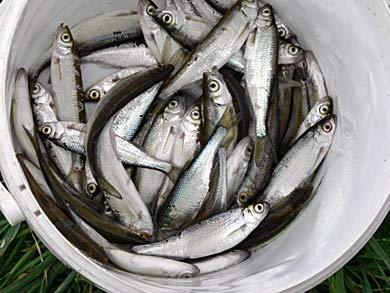
Well, as you know, the asp’s favorite food is bleak. It is also an excellent bait. Having planted a small bleak on a single hook, you can safely assume that the ideal bait has been found, but there are several more very effective baits for catching asp:
- live bait, narrow-bodied, no more than 8 cm in length (bleak is best);
- Chafer;
- insects (grasshoppers, flies, artificial flies);
- small frogs;
- tadpoles.
On what bodies of water can you catch asp?
In winter, asp can be caught on the river, in its non-freezing section. There are such places on all major blue highways in Russia. On the Volga, areas in the Astrakhan region do not freeze, and polynyas form near large hydroelectric power stations (Volzhskaya, Zhigulevskaya, Nizhnekamskaya).
On the lake, you can fish for asp only near the places where underground springs, streams or small rivers flow into the reservoir. The bite will be especially good near natural washouts. It is always better to catch asp in the morning (from 7 to 12 o'clock). Sheresper is active only during daylight hours. At dusk and at night it does not manifest itself at all.
